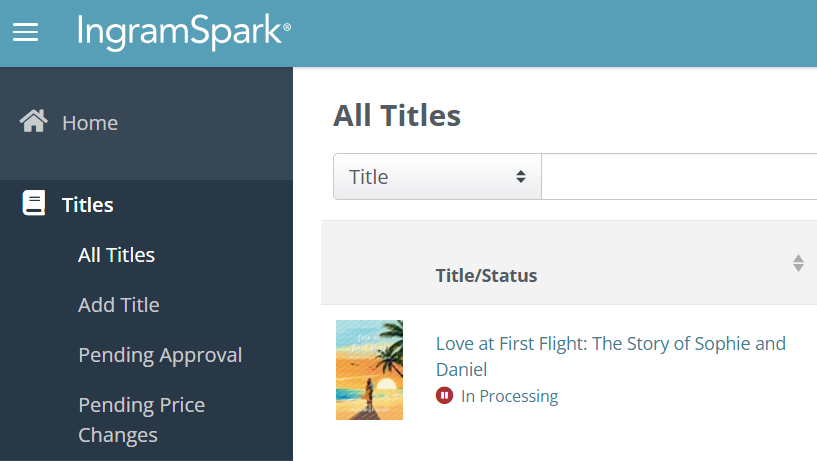Finally Tackling IngramSpark (A Month After Publishing on Amazon)
The platforms require totally different formats.
If you’re an indie author publishing on a budget, you probably know the feeling:
You want your book to be everywhere… but also, formatting is a pain.
That’s where I’ve been for the past month.
My debut rom-com, Love at First Flight: The Story of Sophie and Daniel, launched in April on Amazon and Kindle Unlimited. It was a dream to finally hit publish. The book went live, the ebook and paperback were available, and I proudly posted the link across all my social platforms.
And then… I did nothing with IngramSpark. For weeks.
Why I Waited
I knew I wanted to distribute my paperback more widely—especially to bookstores, libraries, and retailers who prefer not to source from Amazon. That’s where IngramSpark comes in.
I mean, I tried. I really did. But quickly realized KDP and IngramSpark require totally different formats for the cover art + text. For an indie author who loves to write but knows nothing about design, it can take me ALOT of time to figure it all out.
So, every time I opened the site, I’d stare at the IngramSpark submission process and think:
“Ugh. The formatting is totally different from KDP.”
“I don’t have time to figure this out right now.”
“Maybe I’ll just pay someone on Fiverr…”
“Wait—I have a brain. How hard can it be?”
And that’s exactly it. I didn’t want to outsource it. Not because I think authors shouldn’t, but because I’m an indie author with a small budget—and I wanted to learn how to do this myself.
But it took longer than expected.
What’s Different About IngramSpark?
If you’ve published through KDP, IngramSpark feels familiar but fussier. The trim sizes, margins, and file requirements are more precise. Your KDP files won’t work as-is—you need to reformat both your cover art and your interior text.
Here’s what I had to do:
Reformat the existing full-wrap cover in Canva, using IngramSpark’s exact dimensions. Their template generator was great, although having it only available in PDF wasn’t amazing because I had to do my best to crop the template out as precisely as I could, which isn’t as precise as receiving a PNG file like I did from KDP’s cover template generator in the exact dimensions required.
Reformat my Word manuscript, adjusting margins and trim. Also, re-evaluating my fonts because IngramSpark only accepts PDFs, and for the text file, they require fonts to be embedded. This took about an hour of research (Google) and playing around with Word to finally realize I could use my original font - which was a win for me.
Convert the final file to PDF/X-1a:2001, a format IngramSpark loves. Actually, PDF for the cover and text are the only acceptable formats.
So basically, everything is different when it comes to the format of the cover art and your text.
First major milestone passed
After almost a month of procrastination, tinkering, resizing, re-exporting, and second-guessing, I finally got to:
✅ NO ERRORS from IngramSpark’s auto-checkers.
My Canva cover file passed.
My formatted Word doc converted cleanly to PDF.
And the system forwarded me to a beautiful message that said:
Congratulations! You’ve uploaded your book into your IngramSpark account…
Was it dramatic? Yes.
Was I overly proud of myself? Also yes.
Did I immediately screenshot the screen like it was a graduation certificate? Obviously.
But, I’m not done yet. Because beside the congratulatory message, it also read:
… but what’s next?
In 3-5 days, you’ll receive a digital proof of your book
Review and approve the proof for your book
Order a print copy to review
Enable distribution for your book so it can be sold around the world
Note: Because my ebook is enrolled in Kindle Unlimited (which requires exclusivity), I’m only publishing the print edition through IngramSpark—not the ebook. If/when I exit KU, I’ll revisit the ebook side.
Final Thoughts
If you’re an indie author staring down the IngramSpark upload process and thinking, "Not today, formatting demon", I see you.
It’s not glamorous. It’s not instant. But it’s so satisfying when you get it right—and it’s absolutely worth it if you want your book to go beyond Amazon.
I’m excited to finally have Love at First Flight in the Ingram pipeline, and I’ll update you as I progress.
But for now, here’s to learning as we go—and celebrating even the small wins.
—Tracy



